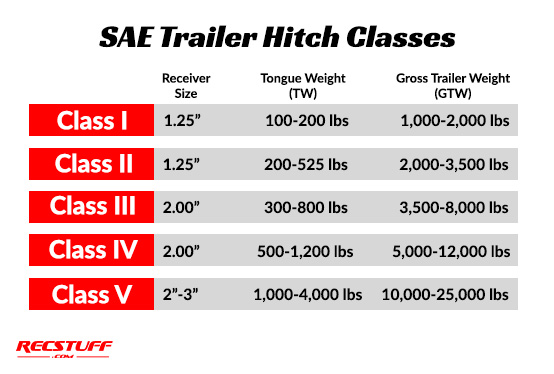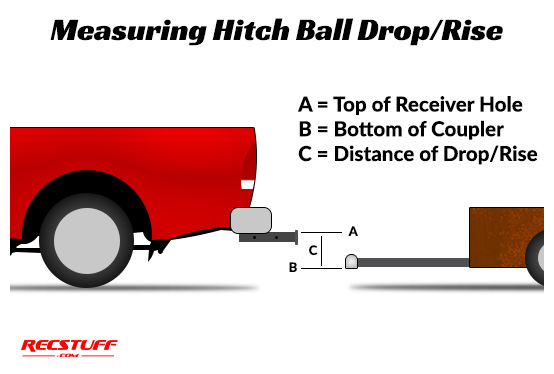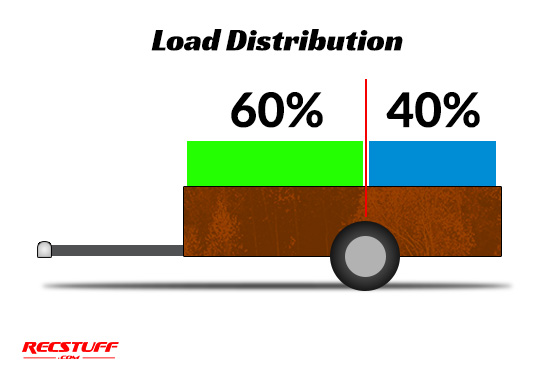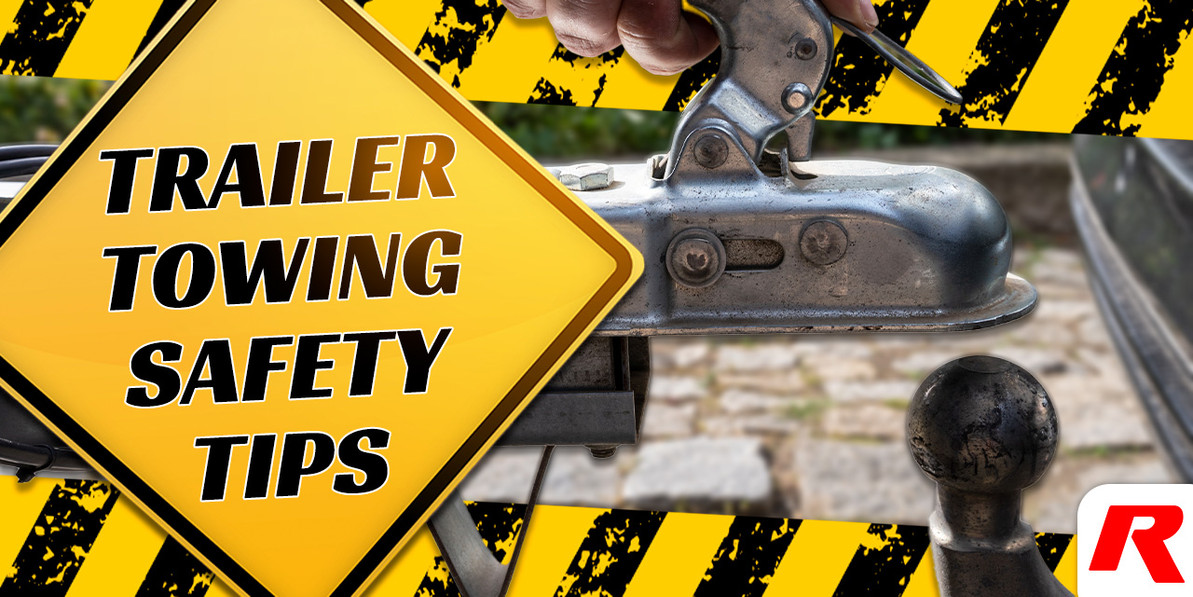Trailer Towing Safety Tips
Towing a trailer presents new challenges when it comes to road safety. Whether you are experienced in towing or a first-timer, it is important to review the basics of towing safety. We have compiled a list of important towing tips to make sure you are traveling safely with your trailer.
NOTE: Always follow the guidelines and recommendations provided by the manufacturer of your trailer, tow vehicle, and any other components being used in your towing system. This article should only be used as a general reference for safe towing practices.
Hitching Safety Tips
Weight Class
Trailer hitches are split into 5 weight classes. Reference the diagram below for information on each class. Double-check the weight class of your hitch before towing. This will be listed in the owner’s manual/instructions, or printed on the hitch itself.

Hitching a Trailer
Before hitching a trailer to your vehicle, always reference the user’s manual/instructions provided by the manufacturer of the vehicle, trailer, and any components you are using. Always follow the specific instructions of the components you are using. The steps below are only to be used as a reference for hitching your trailer.
- Check all components of the trailer and towing systems to ensure they are in proper working order. If any component appears broken or worn out, replace those components. Safety is always worth the spend.
- Verify your vehicle’s towing capacity and check that the load you are carrying does not exceed that limit to prevent damage to your vehicle.
- Ensure that all components are rated greater than or equal to the Gross Vehicle Weight Rating (GVWR) of your trailer. The maximum capacity of your trailer should not exceed the lowest-rated part of your towing components.
- Verify that you have the correct ball mount drop/rise so that the trailer is parallel to the ground when loaded.
- Ensure the ball mount and coupler are attached correctly according to manufacturer recommendations. This includes any safety pins, lighting connectors, and safety chains. Safety chains should be attached from the trailer to the tow vehicle in an “X” formation under the trailer tongue with enough slack to accommodate turning without touching the ground.
Ball Mount Height
Using the correct ball mount is crucial to safe towing. Your trailer should be parallel to the ground when towing. To verify the necessary drop or rise of the ball mount, you will need to measure the distance between the bottom of the trailer coupler to the top of the hitch receiver opening on the vehicle. Make sure the measurements are taken while on level ground.

Loading Your Trailer
Weight Distribution & Balancing Load Weight
When loading your trailer, always follow the guidelines provided by the manufacturer of your trailer. Every trailer is different and the way they are intended to be loaded can vary. The following tips should only be used as a reference for trailer loading and weight balance.
When loading, remember that your trailer’s tongue weight must not be overloaded or underloaded. The general rule to follow is the “60/40” rule where 60% of the load weight is placed in front of the trailer’s axle(s) and 40% of the weight behind the axle(s). Ensure that the load is distributed evenly from side to side, as well. Improper loading can lead to unpredictable handling characteristics and dangerous conditions.

Securing Your Cargo
A correctly distributed load will only work if secured properly. Ensure all cargo securement straps are in working condition and that they are rated for the weight of the load you are securing. Any items in your trailer should be firmly secured in place and unable to shift during transit. Secure your straps on the lower sections of the trailer. Check your straps during stops to ensure they have not loosened during travel. Always remember that the load must be secured for sudden stops, sudden turns, or trailer sway and not just for normal driving conditions.
Tow Vehicle & Trailer Component Safety Checks
Tires
On both trailer and tow vehicles, check the tires to make sure they are up for the task. Start by inspecting the general condition of the tires for any uneven wear and cuts, tears, or abrasions. A damaged tire should not be used for towing and must be replaced. Next, check your tire pressure and verify that they are inflated to manufacturer specifications. Ensure that the load capacity of your tires is not exceeded by the load you are carrying to prevent a blowout.
Mirrors
Make sure all mirrors are present and working properly prior to travel. Adjust your mirrors to prevent any blind spots while towing. Depending on the load, you may need a set of towing mirrors to provide sufficient visibility.
Towing Capacity
Always check your owner’s manual of both your trailer and your tow vehicle to ensure you do not exceed the towing and load capacity they are rated for. The Gross Vehicle Weight Rating (GVWR) is the maximum weight that a trailer and tow vehicle can carry individually. The Gross Combination Weight Rating (GCWR) is the maximum weight allowed for the tow vehicle and trailer when fully loaded. Never exceed the maximum rating of any component in your towing system to prevent damage and accidents.
Driving Safety Tips
Stopping
When towing a trailer, big or small, it is important to maintain a safe distance between you and the vehicle in front of you to accommodate for the extra braking distance. A rule of thumb is to maintain a distance of at least 5 seconds from the vehicle in front. An easy way to measure your gap is to count how long it takes for the back of the lead vehicle to pass a fixed point (i.e: road sign, crack in the road, construction cone) compared to how long it takes for the front of your vehicle to reach that same point. If that gap is less than 5 seconds, reduce your speed to allow for a safe following distance.
Hills
Before reaching a downhill section of the road, let off the accelerator pedal, slow down, and shift into a lower gear. Do not ride your brakes when driving downhill to avoid overheating and potential loss of braking. If you need to brake when towing downhill, apply the brakes gradually, slow to an appropriate speed, and release the brake pedal entirely to prevent overheating.
When towing uphill, shift into a lower gear and monitor your gauges to prevent overheating or over-revving of your vehicle's engine. Reducing speed can help prevent these issues when towing uphill, especially over extended periods.
Reversing
Reversing a trailer is one of the more complicated parts of towing a trailer, even for towing veterans. A good trick to allow for easy trailer reversing is to place your hand on the bottom of the steering wheel. To maneuver right, move your hand right. To maneuver left, move your hand left. Having a spotter outside to provide directions is recommended when possible. If you find your trailer has turned too far, slowly drive forward and try again.
Crosswinds & Swaying
Crosswinds and trailer sway are some of the most unpleasant and dangerous aspects of towing a trailer. If you find yourself dealing with strong crosswinds, reduce your speed and hold the steering wheel straight ahead to reduce the effects.
Per TrailerSafetyWeek.com, when dealing with swaying or “whipping”, remember these rules:
ACCELERATOR OFF, BRAKES OFF, STEER STRAIGHT & WAIT.
Attempting to control a swaying trailer by turning, braking, or accelerating will only worsen the issue. If your trailer is equipped with a brake controller, slowly apply braking to the trailer ONLY.
Ensure your trailer’s load is properly distributed and secured to help prevent this situation.
Sources Cited
Trailer Safety Week, www.trailersafetyweek.com/. Accessed 3 June 2024.
Securing the Load - Purdue Extension, Purdue University Cooperative Extension, June 2008, www.extension.purdue.edu/extmedia/ppp/ppp-75.pdf....
“Trailer User Instructions.” Uhaul.com, www.uhaul.com/Tips/Towing/Trailer-User-Instructio... Accessed 3 June 2024.
Recent Posts
-
Lawn and Garden Tire Information
Spring is here, which means it's time to bring out the lawn tractor and get the yard ready for warme …Mar 24th 2025 -
Snowmobile Trailer Tips
When the snow starts to fall, you may be itching to hop on your sled and hit the trails. However, be …Jan 6th 2025 -
Keep Your Golf Cart on Course - A Guide to Golf Cart Maintenance
Golf carts are a useful and convenient mode of transportation for leisure and for work …Sep 30th 2024




